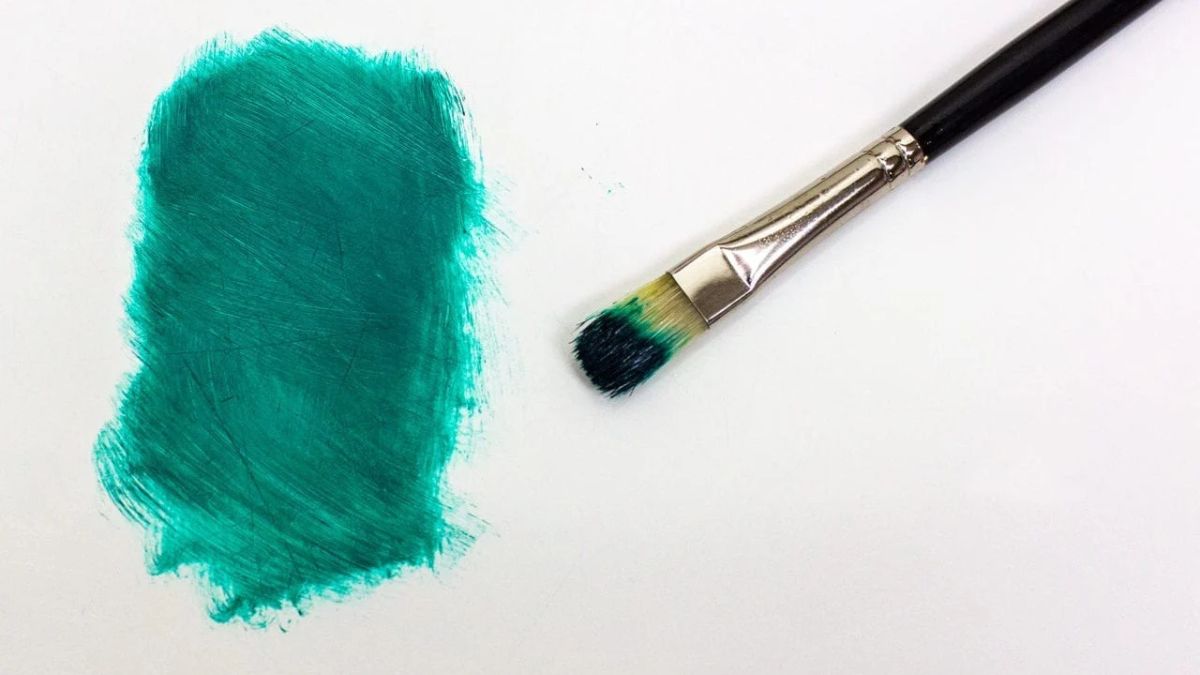TOPIC
The Rich History of Phthalo Green: Mastering the Art of Color

Phthalo Green is a color that has captivated artists and art enthusiasts alike for decades. Its rich, vibrant hue offers an intensity that can transform any canvas into a visual masterpiece. But what lies behind this stunning shade? The story of phthalo green goes beyond mere aesthetics; it weaves together chemistry, history, and creativity in ways you might not expect.
As you journey through the layers of this fascinating pigment, you’ll discover its origins, unique properties, and how it became a staple in the palettes of renowned artists throughout history. Whether you’re a seasoned painter or just starting out on your artistic adventure, understanding phthalo green will enrich your appreciation for color and inspire your creative endeavors. Let’s dive into the colorful world of phthalo green!
The Origins and Naming of Phthalo Green
Phthalo Green, a vibrant and intense pigment, has an intriguing backstory. Its journey began in the late 1930s when it was first synthesized by chemists looking for stable colorants.
The name “phthalo” is derived from phthalocyanine, the chemical compound that gives this hue its striking properties. This term hints at both its molecular structure and vibrant shade.
Initially used for industrial applications, artists soon recognized its potential. They found themselves captivated by how Phthalo Green could evoke depth and emotion in their work.
As painters experimented with this new color, it quickly gained popularity for its remarkable tinting strength and versatility. It transformed landscapes and abstract works alike into stunning visual experiences, solidifying its place in art history.
The Chemistry behind the Color
Phthalo Green, known scientifically as phthalocyanine green, is a synthetic pigment derived from the phthalocyanine complex. Its vibrant hue comes from a unique structure that includes carbon and nitrogen atoms arranged in a specific way.
This arrangement gives Phthalo Green its exceptional lightfastness and transparency. Artists appreciate these properties because they allow for layering without losing vibrancy.
The chemical stability of this pigment means it resists fading over time, making it ideal for artworks intended to last generations.
Additionally, when mixed with other colors, Phthalo Green produces stunning shades—ranging from deep emeralds to rich teals. This versatility makes it an essential choice for painters seeking depth and nuance in their palettes.
Understanding the chemistry behind this color not only enhances appreciation but also informs techniques on how best to use it in artwork.
Characteristics and Uses of Phthalo Green in Art
Phthalo Green is a vibrant, deep hue that stands out in any palette. Artists love its intense saturation and exceptional tinting strength. A little goes a long way, making it both economical and practical for various techniques.
Its transparency allows for stunning glazing effects. Layered washes create depth and luminosity in landscapes or abstract pieces. Phthalo Green also mixes beautifully with other colors, producing rich variations.
Beyond traditional painting mediums, this color shines in mixed media art as well. Its versatility makes it suitable for watercolors, acrylics, and oils alike.
Whether used to depict lush foliage or dramatic skies, Phthalo Green can evoke emotion effortlessly. Many artists appreciate how this shade enhances compositions without overwhelming them—an essential quality in visual storytelling within their work.
Famous Artists who Utilized Phthalo Green in their Work
Phthalo Green has captured the attention of many renowned artists throughout history. Its vibrant hue and versatility make it a favorite choice.
One such artist is Mark Rothko. Known for his large-scale color field paintings, he used Phthalo Green to create depth and emotion in his compositions. The rich tones contributed to the meditative quality of his work.
Another notable figure is Claude Monet. In his later years, Monet embraced this pigment to depict lush landscapes and water scenes. The brilliance of Phthalo Green helped him capture the essence of nature with remarkable clarity.
David Hockney’s use of PhthaloGreen in vibrant portraits showcases its ability to energize a canvas. His playful application breathes life into everyday subjects.
These artists exemplify how Phthalo Green enhances visual storytelling, bringing their unique visions to life through this striking color.
How to Incorporate Phthalo Green into Your Own Artwork
Phthalo Green is a versatile color that can elevate your artwork in surprising ways. Start by mixing it with other hues to create unique shades. Pair it with yellow for vibrant greens or blend it with blue for rich, oceanic tones.
Consider using Phthalo Green as an underpainting base. Its deep pigment creates a stunning foundation, allowing lighter colors to pop on top. This technique adds depth and complexity to your work.
Experiment with various brushes and application methods. A dry brush technique can produce interesting textures, while glazing allows the transparency of PhthaloGreen to shine through subtle layers.
Don’t be afraid to explore its use in different mediums—acrylics, oils, or watercolors all showcase this color beautifully. Whether used sparingly or as the main focus, Phthalo Green has the potential to transform your artistic vision into reality.
Conclusion: Appreciating the Beauty and Significance of Phthalo Green
Phthalo Green is more than just a color; it’s a bridge between nature and creativity. Its rich, vibrant hue has captivated artists for generations, inspiring countless masterpieces. The depth of its tone can evoke feelings ranging from tranquility to excitement, making it a versatile choice in any palette.
This pigment not only holds historical significance but also embodies the spirit of innovation in art and design. Understanding its origins and chemical properties enhances our appreciation of this remarkable shade. By exploring how renowned artists have incorporated PhthaloGreen into their work, we gain insight into its transformative power.
For those looking to infuse their artwork with this vivid color, experimenting with different mediums will yield exciting results. Whether used as an accent or the focal point of a piece, Phthalo Green offers endless possibilities for expression.
As we embrace the beauty of colors like Phthalo Green, we recognize their ability to shape perception and convey emotions through visual storytelling. This green hue continues to inspire new generations of artists who dare to explore its depths and celebrate what makes it truly unique.
TOPIC
Why Goonierne 2 is Set to Change the Game in Its Genre

The gaming landscape is constantly evolving, and one title poised to make a significant impact is Goonierne 2. As the highly anticipated sequel to its predecessor, this game has gamers buzzing with excitement. Fans are eager to dive back into the vibrant world that first captured their hearts. But what makes Goonierne 2 different from the original? With advancements in gameplay, graphics, and storytelling on the horizon, there’s a lot to unpack. So grab your controllers; let’s explore why Goonierne 2 is set to change the game in its genre!
The Success of Goonierne 1
Goonierne 1 made a significant impact on its release, captivating players worldwide. Its blend of innovative gameplay and immersive storytelling drew in gamers from various backgrounds.
The game quickly gained a loyal fanbase. Players were thrilled by the challenges presented and the unique characters they encountered. Goonierne 1 stood out for its vibrant graphics and engaging mechanics, setting a high bar for future titles.
Critical acclaim followed suit, with numerous awards recognizing its achievements in design and narrative depth. Game reviewers praised Goonierne 1 for pushing boundaries within its genre.
As more players dove into this world, discussions flourished across gaming forums and social media platforms. The community contributed to the game’s longevity through fan art, mods, and shared strategies. This collective enthusiasm laid the groundwork for what many anticipated would be an even greater sequel: Goonierne 2.
What Makes Goonierne 2 Stand Out?
Goonierne 2 is not your typical sequel. It takes the foundation laid by its predecessor and builds upon it with innovative ideas that elevate the gaming experience.
One standout element is the enhanced storytelling. Players will encounter deeper character arcs and more intricate plot twists, immersing them in a world rich with lore.
The visual upgrades are equally impressive. The graphics have been overhauled to deliver stunning detail, creating an immersive environment where every frame feels alive.
Gameplay mechanics have also seen significant evolution. New combat systems offer players strategic depth, allowing for varied play styles that cater to both casual gamers and hardcore enthusiasts.
Community engagement has never been stronger. Developers actively seek player feedback to refine experiences post-launch, ensuring Goonierne 2 remains dynamic long after release day.
New Features and Improvements in Goonierne 2
Goonierne 2 introduces a host of innovative features that elevate gameplay to new heights. Players can now explore an expansive open world, filled with hidden treasures and dynamic environments. This freedom encourages exploration like never before.
The character customization options have also seen significant upgrades. Gamers can personalize their avatars with unique skills, appearances, and backstories, allowing for deeper immersion in the game’s narrative.
Combat mechanics have received a complete overhaul. The addition of fluid animations and responsive controls makes every encounter more engaging and strategic.
Moreover, cooperative multiplayer modes allow friends to team up seamlessly or engage in competitive challenges against one another. This social aspect enhances player interaction while adding layers of excitement.
Enhanced AI ensures that non-playable characters react realistically to players’ actions, creating a more believable world where choices truly matter.
Early Reviews and Hype Surrounding the Game
Early reviews of Goonierne 2 have been nothing short of electrifying. Critics and gamers alike are buzzing with excitement. The anticipation is palpable, as enthusiasts eagerly share their thoughts across social media platforms.
Many point to the innovative gameplay mechanics that elevate the experience beyond its predecessor. Reviewers praise stunning graphics that immerse players into a beautifully crafted world.
Community engagement has also surged, with forums alive with speculation and theories about new storylines. Content creators are diving deep into sneak peeks, generating even more chatter.
The hype train shows no signs of slowing down as fans await release day with bated breath. It’s clear that Goonierne 2 is not just another sequel; it’s shaping up to be a defining moment in gaming history.
The Impact of Goonierne 2 on the Gaming Industry
Goonierne 2 is poised to redefine the gaming landscape. Its innovative mechanics and storytelling approach are setting new benchmarks for future releases.
Developers everywhere are taking notice. Many will likely adopt its unique blend of gameplay elements, striving to capture the same magic that Goonierne 2 has achieved. This could lead to a wave of fresh titles that push creative boundaries.
The game’s success also highlights the growing demand for immersive experiences in the industry. Players crave depth, character development, and engaging narratives—traits Goonierne 2 delivers seamlessly.
As it gains traction, Goonierne 2 may inspire indie developers as well. The game’s accessibility encourages smaller studios to explore ambitious ideas without fear of failure.
This title isn’t just a sequel; it’s a catalyst igniting conversations about what games can achieve in terms of artistry and innovation within an evolving market.
Conclusion: Is Goonierne 2 Worth the Hype?
As the gaming community eagerly anticipates Goonierne 2, excitement continues to build. The sequel promises to elevate the experience with its innovative features and immersive storytelling. While some might wonder if it can live up to the legacy of its predecessor, early reviews suggest that players are in for a treat.
The enhancements made from Goonierne 1 to Goonierne 2 indicate a strong commitment by developers to listen to feedback and evolve the gameplay. With new mechanics, improved graphics, and an expanded universe, it’s clear that significant effort has gone into creating something special.
While only time will tell how Goonierne 2 truly impacts the genre and what place it will hold within the gaming landscape, one thing is certain: anticipation around this title is palpable. Players are excited not just about revisiting familiar elements but exploring fresh content that redefines their expectations.
For fans of action-adventure games or anyone looking for an engaging narrative combined with dynamic gameplay, there seems little reason not to be optimistic about diving into this highly anticipated release. Only when gamers finally get their hands on Goonierne 2 will they determine if it lives up to all its hype.
TOPIC
Grounded or Ready? How the Aircraft MRO Market Is Powering the Future of Aviation

In early 2022, a leading airline in Europe faced a crippling issue—over a dozen aircraft were grounded due to delays in engine maintenance. These delays weren’t because of missing parts or workforce protests. The bottleneck? A global MRO capacity crunch.
As travel rebounded faster than expected, the aviation industry realized something startling: while aircraft deliveries resumed and passenger demand soared, the MRO infrastructure wasn’t ready to support the surge.
Did you know? According to Stratview Research, the global Aircraft MRO market, valued at over US$ 250.8 billion in 2024, is projected to surpass US$ 292.5 billion by 2034, growing at a CAGR of around 1.4%. Yet, even as the market expands, the ecosystem is under pressure to modernize, decentralize, and digitize—fast.
Problem: The Post-Pandemic MRO Bottleneck
The pandemic grounded aircraft worldwide. Entire fleets were stored in deserts, terminals, and hangars. Maintenance cycles were paused. Talent—particularly technicians—left the industry or aged out. Now, as aircraft return to the skies, the MRO sector is struggling to keep pace.
Here’s what the industry is facing:
- A growing backlog of scheduled and deferred maintenance
- A workforce gap, especially in skilled labor for engine overhauls and line maintenance
- Long lead times for parts, especially for legacy aircraft still flying due to delivery delays of newer models
- Aging fleets, particularly in regions like North America and the Middle East, requiring intensive MRO work
Agitation: Why This Challenge Is Bigger Than Just Delays
A delayed maintenance check isn’t just a scheduling hiccup—it can ripple across an airline’s entire network, disrupt operations, inflate costs, and strain customer satisfaction.
Consider this:
- Airlines lose thousands of dollars per hour for each grounded aircraft.
- Engine maintenance, which accounts for ~40% of total MRO spending, is seeing average turnaround times increase by up to 25% in some regions.
- More aircraft are flying longer hours with fewer maintenance slots available—a dangerous cocktail in a safety-first industry.
And yet, MRO demand is set to skyrocket. Stratview Research notes that over 40,000 new aircraft are expected to be delivered between 2024 and 2040. Add to this the resurgence of narrow-body fleets from low-cost carriers, and the MRO demand curve bends sharply upward.
Solution: How the Aircraft MRO Market Is Adapting and Evolving
Despite the challenges, the Aircraft MRO industry is undergoing a transformation, with innovation and regional expansion leading the way.
- Rise of Asia-Pacific as the Fastest-Growing MRO Hub
- Countries like India, Indonesia, Malaysia, and Vietnam are investing in MRO infrastructure to serve booming domestic and regional fleets.
- According to Stratview Research, Asia-Pacific is the fastest-growing MRO region, driven by a large installed base of aircraft and cost-competitive labor.
- Engine MRO: The Largest and Most Lucrative Segment
- With newer engine models (e.g., LEAP, GTF) seeing increased adoption, specialized MRO providers are emerging with digital diagnostics, predictive analytics, and integrated supply chain capabilities.
- Engine OEMs like CFM, Rolls-Royce, and Pratt & Whitney are expanding MRO partnerships globally to keep up with demand.
- Digital Transformation Is Gaining Altitude
- Airlines and MRO providers are investing in AI-powered inspection tools, blockchain for parts tracking, and cloud-based maintenance management platforms.
- Predictive maintenance is helping reduce AOG (Aircraft on Ground) events by anticipating failures before they occur.
- Collaborations and Joint Ventures Are Filling Capability Gaps
- Strategic partnerships between airlines, OEMs like Boeing, and third-party MRO providers are helping to expand capacity quickly.
- For instance, major MRO providers in Singapore, South Korea, and the UAE are entering into alliances to handle engine, avionics, and composite repairs at scale.
What Forward-Thinking Stakeholders Are Doing Differently
- Airlines are vertically integrating MRO capabilities or entering joint ventures to gain control over turnaround times and cost structures.
- OEMs are offering “Power-by-the-Hour” contracts that bundle maintenance with performance guarantees.
- Governments, especially in emerging markets, are offering tax benefits and infrastructure support to attract MRO investment.
- Private equity is flowing into niche MRO segments like component repair and digital inspection startups.
Strategic Takeaways for the Decade Ahead
- MRO is no longer just an operational function—it’s a strategic differentiator.
- The shift from reactive to predictive maintenance will determine which airlines maintain fleet readiness at competitive costs.
- As Stratview Research projects, engine MRO, component repair, and airframe maintenance will continue to be the pillars of MRO spending, each evolving with digital enablers.
- Geopolitical shifts and rising labor costs in the West will drive more MRO work toward Asia and the Middle East.
Final Descent: What Comes Next?
As aircraft take to the skies in record numbers, the demand for faster, smarter, and more localized MRO services will only intensify. The leaders in the next chapter of aviation won’t just fly more—they’ll maintain better.
TOPIC
What Makes Foxfiny com Stand Out in the E-commerce World?

In the bustling world of e-commerce, countless platforms vie for attention. Amidst this competitive landscape, Foxfiny.com has carved out a unique niche that sets it apart from the rest. With its user-friendly interface and innovative features, it’s not just another online marketplace; it’s a vibrant community where businesses can thrive.
From aspiring entrepreneurs to established brands, Foxfiny.com offers an array of tools and resources designed to empower sellers. But what truly makes this platform stand out? Let’s dive into the distinctive aspects that make Foxfiny.com a game-changer in the realm of online shopping and business growth.
The Unique Features of Foxfiny com
Foxfiny com offers a refreshing approach to online shopping. Its user-friendly interface makes navigation effortless, allowing customers to find products with ease.
One standout feature is the personalized shopping experience. The platform uses advanced algorithms to recommend items based on individual preferences and browsing history. This tailored touch helps shoppers discover new favorites.
Additionally, Foxfiny com emphasizes sustainability by promoting eco-friendly products. Shoppers can explore categories dedicated to green living, making it simpler for environmentally conscious buyers.
Another key aspect is the seamless integration of social features. Customers can share their finds and purchase experiences, creating a community around shared interests and styles.
Foxfiny com’s commitment to customer support sets it apart from other platforms. With responsive service teams available around the clock, assistance is just a click away whenever it’s needed.
How Foxfiny com is Different from other E-commerce Platforms
Foxfiny com redefines the e-commerce experience with its user-centric design. Unlike many platforms, it prioritizes simplicity and efficiency. Navigating through products feels seamless, allowing customers to find what they need without frustration.
The platform also offers personalized recommendations driven by advanced algorithms. This means shoppers discover new favorites tailored to their preferences, enhancing overall satisfaction.
Moreover, Foxfiny com emphasizes community engagement. It encourages interaction between buyers and sellers through forums and reviews, fostering a sense of trust that is often missing in larger marketplaces.
Additionally, the commitment to local businesses sets Foxfiny apart. By giving small entrepreneurs a robust platform to showcase their products, it champions diversity in offerings while supporting local economies.
With innovative payment options and swift delivery services integrated into the shopping process, Foxfiny com stands as a fresh alternative for discerning consumers seeking more than just transactions.
Customer Reviews and Testimonials
Customer reviews and testimonials play a crucial role in shaping the reputation of Foxfiny com. Shoppers often share their experiences, highlighting the platform’s user-friendly interface and vast product selection.
Many users appreciate how seamless the shopping experience is from browsing to checkout. Positive feedback frequently mentions quick delivery times, which enhances customer satisfaction.
Testimonials also reflect the quality of customer service on Foxfiny com. Buyers report prompt responses to inquiries and effective resolution of issues, fostering trust between consumers and sellers.
Moreover, businesses sell on this platform praise its marketing tools that help them reach their target audiences efficiently. These success stories further enhance consumer confidence in choosing Foxfiny com for their online shopping needs.
Success Stories of Businesses on Foxfiny com
Numerous businesses have thrived on Foxfiny com, showcasing the platform’s potential. One standout story is a local artisan who transformed their craft into a flourishing online store. With appealing visuals and strategic marketing, products flew off the virtual shelves.
Another success comes from an emerging fashion brand that leveraged Foxfiny’s user-friendly tools to reach global audiences. They experienced rapid growth by utilizing targeted promotions that resonated with customers.
A tech startup also found its footing here. By embracing Foxfiny’s analytics features, they fine-tuned their offerings based on real-time feedback, leading to increased sales and customer satisfaction.
These stories illustrate how diverse businesses can harness the power of Foxfiny com for impressive outcomes in various industries. Each journey highlights creativity and adaptability as key ingredients for success within this vibrant e-commerce ecosystem.
Tips for Businesses to Succeed on Foxfiny com
To thrive on Foxfiny com, businesses should start by optimizing product listings. Use high-quality images and detailed descriptions that highlight unique features.
Engage with your audience through social media and email marketing. Building a community around your brand fosters loyalty and drives traffic to your store.
Utilize the platform’s analytics tools to track performance. Understanding consumer behavior can help you refine strategies effectively.
Consider running promotions or limited-time offers. Creating urgency encourages customers to make quicker purchasing decisions.
Don’t overlook customer service; prompt responses build trust and enhance satisfaction. A positive shopping experience leads to repeat business.
Encourage feedback from buyers. Reviews not only improve credibility but also provide valuable insights for growth opportunities on Foxfiny com.
Conclusion and Future of Foxfiny com in the E-commerce Industry
The future of Foxfiny com in the e-commerce industry looks promising. As more businesses seek innovative ways to reach customers, this platform continues to evolve and adapt. Its unique features cater not only to sellers but also enhance the shopping experience for buyers.
Foxfiny com is positioning itself as a formidable player by focusing on community engagement and support for entrepreneurs. This approach fosters loyalty among users, encouraging repeat business and referrals.
Looking ahead, it’s clear that Foxfiny com aims to remain at the forefront of e-commerce trends. By embracing technology and prioritizing customer satisfaction, it sets a standard that others may strive to meet. For both new startups and established brands looking for growth opportunities, Foxfiny com presents an attractive option filled with potential.
As we watch its journey unfold, one thing is certain: Foxfiny com has carved out a niche in the crowded e-commerce landscape that is worth keeping an eye on.
-

 TECHNOLOGY2 weeks ago
TECHNOLOGY2 weeks agoTop 10 Must-Read Stories from Kristen Archives You Can’t Miss
-

 TECHNOLOGY6 months ago
TECHNOLOGY6 months agoSky Bri Net Worth Revealed: How She Built Her Financial Empire
-

 TOPIC8 months ago
TOPIC8 months agoBasement Renovation Contractors: How They Tackle Structural Issues During Renovations
-

 TOPIC3 months ago
TOPIC3 months ago5 Reasons the //Vital-Mag.Net Blog Dominates Lifestyle
-

 TOPIC1 month ago
TOPIC1 month agoTop 10 Articles from the ://Vital-Mag.net Blog That You Can’t Miss
-

 CRYPTO5 months ago
CRYPTO5 months agoCrypto30x.com Review: Is It the Right Platform for You?
-

 BUSINESS3 weeks ago
BUSINESS3 weeks agoTraceLoans Explained What You Need to Know
-

 BUSINESS1 month ago
BUSINESS1 month agoDecoding the Kennedy Funding Ripoff Report: Facts vs. Fiction
